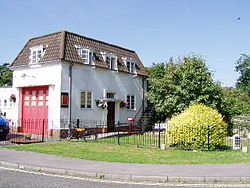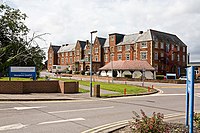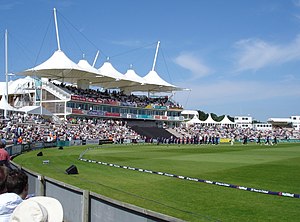West End, Hampshire
| West End | |
| Hampshire | |
|---|---|
 The old fire station, West End | |
| Location | |
| Grid reference: | SU471138 |
| Location: | 50°55’19"N, 1°19’51"W |
| Data | |
| Population: | 11,470 (2011) |
| Post town: | Southampton |
| Postcode: | SO30, SO18 |
| Dialling code: | 023 |
| Local Government | |
| Council: | Eastleigh |
| Parliamentary constituency: |
Eastleigh |
| Website: | West End Parish Council |
West End is a village in the south of Hampshire, five miles east of the city of Southampton.
The village is small and generally classed as an area in the outer suburbs or rural urban fringe of Eastleigh because of the surrounding woodland and countryside, including Telegraph Woods and Itchen Valley Country Park.
The village is mainly known for being home of the Rose Bowl, the stadium where Hampshire County Cricket Club plays, and occasionally England.
The main landmarks of the parish are Moorgreen Hospital — a large, ornate Victorian building, the original St James School, built in 1901, on the high street, and West End Fire Station — a museum in the centre of the village.
History
Early history
A series of round barrows, dating from the Bronze Age (2000-600 BC), have been discovered in the Moorgreen area of the parish. There were five of these to the north of the former Moorgreen Hospital site. A hilltop fort from the Iron Age was built on the ridge above the village around 600-100BC.
A shutter telegraph station operated from the site during the Napoleonic Wars, forming part of the line connecting London to Plymouth. It was this station that gave the name to the nearby Telegraph Woods.
The village was originally a hamlet which grew up around a track between Romsey and Portsmouth. The hamlet had a chapel by 1552 primarily for the use of the lords of the manor of Allington. When the track became a turnpike road in the early 19th century, the hamlet began to grow.
19th century

In 1838, a national school was opened to house 192 children.
The ecclesiastical parish of West End was established in 1840, two years after the construction of the original St James' Church. In 1846 a Bible Christian chapel was constructed in Chapel Road.
A poor house had existed at the eastern end of the village for some time, and in 1848 this was replaced by a red-brick workhouse. This eventually became Moorgreen Hospital.
An extra room was added to the national school in 1866. In 1871 an independent school for younger children was opened, having been built by Mrs Harriet Hazlefoot.
In 1890, the spire of St James' was struck by lightning and the building was replaced. The civil parish was established in 1894. A number of boundary changes have taken place since then.
20th and 21st century
In 1900, two further Methodist chapels were built, one in the Moorgreen area and one in Swaythling Road. In September 1904 the children of the national school were moved to a new location with the old school building becoming the parish hall.
The fire station was opened in 1939. It was closed in 1996 and the building was transferred to the parish council to run as a community venue.
A Roman Catholic church building was opened in the village in 1961.

The Rose Bowl cricket ground was built in 2000 along with an accompanying hotel and conference facilities and a 18-hole golf course. It has hosted several international cricket games and a number of well known musical acts.
Culture and community
The annual West End Carnival takes place each June, although it did not run in 2009 or 2010 due to a lack of volunteers. The parish has an active local history society which runs a museum in the old fire station in the village centre.
Sport
- Cricket: Hampshire County Cricket Club's home ground, the Rose Bowl, is in the east of the parish between the M27 and Telegraph Woods. It has a hotel adjoining.
Outside links
| ("Wikimedia Commons" has material about West End, Hampshire) |
